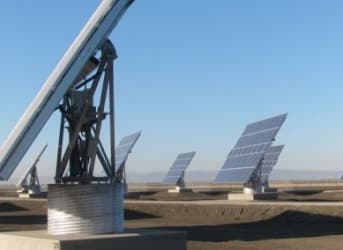The ongoing volatility in the oil markets has led many major companies to dramatically slash their capex budgets and workforces in a bid to survive. The knock on effect of this can be seen in a burgeoning solar industry that is seizing the opportunity to finally make a significant breakthrough into the market, regardless of subsidies.
Research and consultancy group Woods Mackenzie believes we may have a shale-like boom on our hands. According to their new report “Is solar the next shale?” distributed and utility scale solar is nearly ready to transform power markets. And for this, we can thank China.
The world’ s most populous nation is not wavering in its concerted effort to bring solar to the masses and reduce the country’s marked pollution. China has vowed an installed capacity of 70 gigawatts (GW) by 2017 – or double Germany’s current world-leading capacity. Last year the country installed 10.6 GW, bringing their total grid-connected capacity to just above 28 GW.
The core of China’s growth consists of the belief that solar can indeed be cheaper than coal, and of course an exploding photovoltaic (PV) manufacturing industry, which has rapidly depressed global prices. Since 2007, Chinese PV module production has increased nearly 20-fold to 25 GW and is projected to reach 51 GW by the end of 2017. This is beyond good news for the rest of the world because solar PV costs follow a largely predictable trajectory – subject to a phenomenon many refer to as Swanson’s law. The law stipulates that for every doubling of global manufacturing capacity, the dollar per watt cost of PV cells falls by 20 percent. It has held true for nearly 40 years and data from the US Department of Energy’s National Renewable Energy Laboratory suggests we can expect the same moving toward 2030. Related: Anti-Fossil Fuel Movement Grows
Ahead of the game, China’s solar industry believes the levelized cost of solar PV will equal that of coal-fired generation by the end of 2017, at the latest. The US, for its part, is nearly there in several states, and not much farther behind in others. In California for example, utility scale solar is already competing with natural gas – and is prepared to blow it away (see below).

Source: Woods Mackenzie
The above chart from Woods Mackenzie’s recent report reveals the rapidly growing profitability of investing in solar generation compared to both combined cycle and combustion turbine natural gas plants. It’s part of a national trend that is picking up pace as solar costs continue to fall while combined cycle costs rise.

Source: Woods Mackenzie
By 2020, the consultancy expects 19 states to be at grid parity, doubling to 38 by 2030 – even without the Obama administration’s successful solar tax breaks. The projections assume installed distributed and utility scale solar capacity of 71 GW by 2035, or more than three times the current level. Related: The World's 10 Biggest Solar Farms
Such rapid expansion is certainly possible, but the electric and market systems will require a revamp as current structures are not designed for such a large influx of solar energy. As solar undercuts natural gas plants and other forms of electricity generation, it amasses revenues otherwise not its own. A boon to solar, a blow to gas, and the cycle continues. However, electric systems still require backup capacity during low-solar hours and under current compensation mechanisms fossil fuels cannot afford to be relegated to a secondary role.
ADVERTISEMENT
For the time being, solar’s dominance over fossil fuels is only constrained by its increasingly rapid growth. Growth, however, is all but guaranteed as improvements to efficiency and cost advance like clockwork. Clean energy saw a 16 percent rise in investment in 2014 and has weathered oil’s fall relatively unharmed. It’s time the markets evolve.
By Colin Chilcoat of Oilprice.com
More Top Reads From Oilprice.com:
- Obama Pledges Cleaner Future In State Of The Union
- Renewables Could Revolutionize African Energy
- Scientists Improve Efficiency Of Organic Solar Cells


















